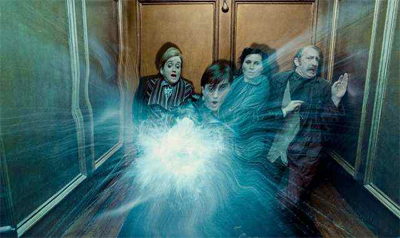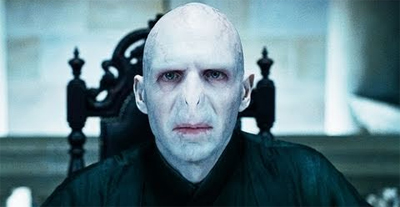Even in this era of franchises and spin-offs and sequels and remakes to see a movie treated as a form of serialised fiction. I’m not even talking about a sequel hook inserted just before (or even during) the trailers, but I’m talking about literally taking one whole movie and dividing it and then releasing separately. It’s an approach that worked for The Empire Strikes Back and Return of the Jedi, and for The Lord of the Rings, but each Harry Potter film until now has felt like its own story, containing threads building towards a larger finale. Each instalment has been structured with a beginning, middle and end. With Harry Potter and the Deathly Hallows, Part I, we simply get a first act and what feels like the majority of the second. As such, it feels almost strange to review it without the companion film.
Nevertheless, we’ll give it a go. After all, the cliffhanger ending and lack of any sense of resolution can’t be a surprise to anyone who reads movie news or even the last two words of the title in question. It does make the movie quite difficult to judge on its own merits, but there is enough substance to be found in the film that it merits discussion on its own terms. In fact, it’s quite a solid little addition to the franchise, with the sense that everything is sort of settling into place, and the films are starting to feel quite comfortable with themselves.
Truth be told, you pretty much know what you’re going to get, which feels like a particularly lazy observation, but I think it’s fair in context. In many ways, the movie seems to have carried over a lot of the aesthetic from the last film, Harry Potter and the Half-Blood Prince, which is to say that it is significantly darker and far more gothic. The series has always worked remarkably well with special effects, and in creating a genuine sense of, for lack of a better word, magic hidden amongst the every-day world. Those nice touches are present here, with the Ministry of Magic accessible through the flushing of a toilet, for example, or the recurring “stretching” of reality to reveal an object hidden from ordinary eyes (a semi-detached house hidden between two others, for instance).
Things are getting genuinely darker, both thematically and in terms of lighting. I have to admit, and this might just be me seemingly like an old curmudgeon, but found the earlier sections of the film ridiculously desaturated – to the point where the cast looked like exiles from Twilight and it was difficult to tell what was going on. As the movie switched back to Earth as opposed to the more ethereal magic realms, I thought that the style worked infinitely better, with sparse rocky landscapes and burnt-out trailer parks serving to illustrate the isolation that our heroes must feel. David Yates does a nice job with these bits, but they could really do well to turn up the saturation just a tad when we enter the world of magic.
Thematically, I actually really like the way that the series handles Voldemort’s regime, as it were – clearly modelled around a very human fascist dictatorship. It’s not exactly a difficult or a nuanced metaphor to apply, but it works in the context of the films. After all, it’s a fitting cautionary tale for any kids in the audience, and makes an effective point of reference, as Voldemort executes a teacher for daring to suggest “muggles are not so different from us.” There’s something very telling about how Harry isn’t branded as a “fugitive” or “public enemy”, but rather “undesirable no. 1”, with the racist term “mudblood” used for wizards with mortal DNA.
It’s very easy for a film or series to use the conventional trappings of Nazi-ism, as the movie does here – foot soldiers march around with armbands, people disappear and Voldemort even uses the very fascist-sounding slogan, “magic is might.” However, I respect the film for daring insert some of the ideology into the narrative, illustrating that it isn’t just the stylistic elements of the doctrine that are harrowing of themselves: it’s the fact that a mere change in government can lead to the erection of statues of “muggles… in their rightful place”, crushed and exterminated. It’s still a powerful suggestion, one that is terrifying and disturbing – as well it should be. The moment that such a thought isn’t troubling or disturbing is the moment we need to worry.
Still, while the pace of change effectively conveys just how uncertain Harry Potter’s world has become, it doesn’t really work from a narrative point of view. Because this is the final instalment of the series, supporting characters begin to pass away in incredibly large numbers. After all, the last chapter ended with a pretty significant death. However, the problem is that the losses of such key players seem to happen off-screen, with expository dialogue and proclamations informing us that a given character is dead. Two rather recognisable faces meet this fate within the opening hour of the film, and it feels strangely like a cop-out.
This sort of storytelling works well for a novel, but not really for a film. It doesn’t really make a great deal of difference whether you read the line “x is dead” or a character announcing “x is dead.” However, on the big screen, actions speak louder than words. We’re informed early in the film that Voldemort and his evil forces have taken control of the Ministry of Magic, but we aren’t shown the attack, or even its aftermath. We are only later shown the Ministry staffed by evil individuals, refurnished to fit the new party manifesto. Still, it seems like Voldemort is still skulking around in the background, as if he’s still putting his plan into effect, even though he’s now in control of the establishment.
That should be terrifying – the idea that this racist dictator controls all aspects of wizard society. And the film handles a lot of it quite well – the press comes under his thumb almost instantly, for instance, and the Ministry of Magic begins racially profiling its staff – but the problem is that it never seems like Voldemort is really in control of the situation. His little evil cabal is still operating out of a friend’s house, for example, rather than anything resembling an official building. He’s still sending his own accomplices after Harry Potter, rather than using the system against the fugitives. The most powerful moment in the film comes near the end, where a trusted friend betrays them to the powers that be, who hold a horrible leverage. There should be more moments like that.
Still, these complaints are relatively minor. The movie works well as a chase film, with our heroes racing against time to collect a whole bunch of macguffins. It’s fascinating to note the recurring use of the “individual pours great power into collection of trinkets” theme, as the kids race to collect a particular bunch of plot-relevent objects, but those individual objects seem to change. First it’s the items that Voldemort transferred his essence into, which Harry hopes to use to defeat him. Then, towards the end of this film, it’s the Deathly Hallows, three items forged by Death Itself. “Together,” it’s explained, “they make one master of death.” Just as the items Voldemort poured his soul into make those who collect them master of him, after a fashion. It feels a little strange that the goalposts seem to change so much, but they do make for effective plot tokens.
And, I must confess, I love the animated sequence explaining the origins of the Deathly Hallows. It’s a nice little sparse style that works really well, and the music and narration come together to create the effect of an old oral folk tale being played out before the audience. It’s certainly a rather neat little scene, and one of the strongest moments in the entire franchise.
So, it’s hard to tell if the movie really works at this point, but a lot of evidence points to it being a solidly entertaining ride. The cast are comfortable in their roles, David Yates is confident with his direction, and the movie drips with a dread atmosphere, as things threaten to get a lot worse before they (hopefully inevitably) get better. It’s a shame that the movie doesn’t necessarily work as a stand-alone piece of cinema, so perhaps judgement may have to be observed. But, if the second half maintains the standard set here, it should make a satisfying conclusion to the saga.
Read our Harry Potter reviews:
- Harry Potter and the Philosopher’s (Sorcerer’s) Stone
- Harry Potter and the Chamber of Secrets
- Harry Potter and the Prisoner of Azkaban
- Harry Potter and the Goblet of Fire
- Harry Potter and the Order of the Phoenix
- Harry Potter and the Half-Blood Prince
- Harry Potter and the Deathly Hallows, Part I
- Harry Potter and the Deathly Hallows, Part II
Filed under: Movies | Tagged: David Yates, harry potter, Harry Potter and the Deathly Hallows, Harry Potter and the Half-Blood Prince (film), Hogwarts, lord of the rings, Lord Voldemort, Ministry of Magic, Voldemort |


























I think this is my favorite of the franchise so far even though it’s very much one half of a movie. The main trio of actors are now fully fleshed out both as characters and performers. While there is a lot of sitting around in the woods, I liked that the movie is taking a bit of a pause and contemplating the abyss facing them. It’s the lull before the storm some might say.
Nah, I think I’d go with Goblet of Fire. I was dreading going into that one, because the film I saw directly previous was the Chamber of Secrets. I remember that being painful. and I actually really loved that. if I had been blogging, I suspect that one might have made the bottom of my end-of-year top ten.
It is a bit weird trying to review this movie, since one could easily argue that the whole thing is rising action leading into the events of the second half. Ever tried reviewing a movie without watching the third act? That’s a bit how I felt trying to write about this one myself. I think that all of the stuff of part one will lead to a huge payoff in part two, but that doesn’t make the experience any less weird.
Yep, part of me is really glad I went out of my way to watch this before watching the last part tomorrow. I can only imagine how lost I’d be…